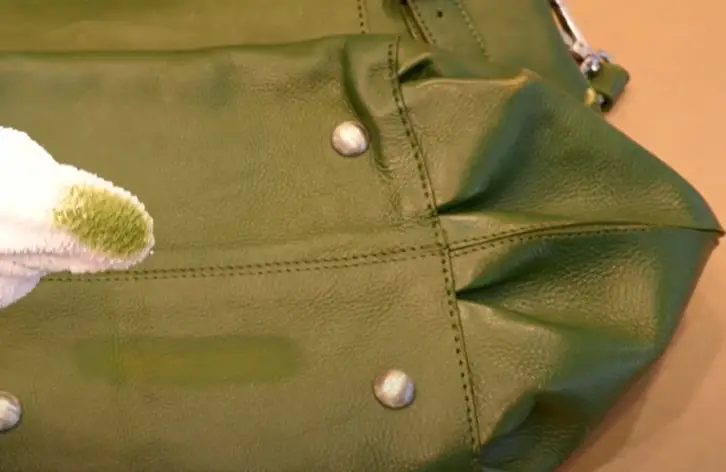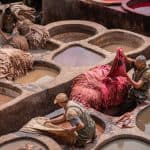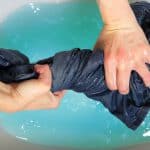New leather products or freshly dyed leather can rub off on many surfaces. Getting dye stains on your clothes, car seats, or anything that your belt or bag might rub off on could ruin those things and ruin your day. Here’s how to prevent this from happening.
What is leather dye made of?
Leather dyes can come in three main varieties, alcohol-based, water-based, and oil-based. There are also dyes that are alcohol and oil mixed together in different ratios that allow for different results.
Ingredients of leather dyes
Leather dyes usually consist of three main ingredients and some minor ones. The three main ingredients are pigments, binders, and solvents.

These three can come from and be made of wildly varying things. Some pigments come from plants and fruits like walnuts or berries, while other pigments can come from metals like ferrous or copper sulfates. Just like how berries can stain your clothes, leather with strong dyes that haven’t been sealed or are freshly dyed would need some prep done to it to stop it from rubbing off.
Binders are usually made from different types of resins and they can also come from natural sources as well. Binders are the key ingredient that allows for the dye to set and stay permanent. Without binders, the colors would get washed off much easier than without it, they’re also why it’s a headache to remove dyes from anything absorbent if you spill any.
Lastly, you have the solvents. The ingredients are dissolved in the solvents and the solvents are made to either evaporate or absorb and then evaporate.
Alcohol is a common solvent used in dyes as it evaporates quite quickly so drying time is much less. Water is also another very common solvent and it absorbs into the leather and doesn’t evaporate as quickly, allowing for the dye to go deeper into the leather. Oil-based dye also does something similar to water but prevents the leather from becoming too dry after dyeing.
Why is my leather dye coming off?
There are many reasons why the leather dye is coming off your leather item. In order to prevent this, you must be aware of why it’s happening in the first place. Here are some of the possible reasons why your leather dye is rubbing off:
Contact with water
This is the most common cause of why the leather dye on your item is peeling off. For real leather, when it comes into contact with water or any liquid, it penetrates the pores and causes the dye molecules to break down and wash away.
For faux leather, the water can damage the protective coating on top and expose the dyed or painted layer of the item. This opens up the possibility of it rubbing off very easily from then on.
Excess dye
Too much dye used on the item can cause oversaturation; eventually, the dye used will wash away easily. If there is too much dye on the product, there is also a huge chance that it will rub off on any item that comes into contact with it.
Sweat and body oil
If you notice that the dye is coming off on certain parts of your leather item, it’s important to note whether your body parts get rubbed on them often. Grease from your body and salt stains from your sweat can definitely cause discoloration. It will also react with the dye causing it to become unstable and sensitive, thus leading to the color fading or rubbing off.
Alcohol-based and water-based dyes
Sometimes, alcohol-based dyes when combined with moisture and constant contact with other items can cause weaker bonds between the dye and the leather. This means that different types of dyes rubbing with each other can cause a rub-off. When it comes to water-based dyes, the bond is weaker since they cannot form a reliable bond with water-based sealants. This is also a common cause for dyes to rub off.
Unmixed dyes
If you’re planning to DIY a dyed leather item, keep in mind that if the dyes aren’t mixed enough or not applied properly, it leads to some parts rubbing off. If you’re dealing with store-bought dyed leather goods, then this shouldn’t be a problem.
Black leather dye
If your leather goods are dyed black, then they are immediately more prone to rubbing off or fading. Most black dyes used in these items contain aniline, which is a water-soluble component and can lead to the dye easily rubbing off.
How to stop leather dye transfer
There are many easy ways that you can prevent the leather dye from rubbing or peeling off from your leather goods. Here are some that you can do at home:
Use a leather protector
Using a sealant or a leather protector can bring many benefits to your precious leather items. If you’re already familiar with leather care and maintenance, you probably know about the process of cleaning, conditioning, and protecting the leather using leather-friendly products.
Leather protectors come with UV protection and stains and water-repellant features that are key to preventing sun and liquid-caused damages. Using a leather protector can prevent discoloration, dryness, stains, and fading caused by the dyes rubbing off.
Steps:
- Clean the entire surface of your leather item using a microfiber towel.
- If necessary, clean and condition your item before applying the leather protector.
- For suede and nubuck, you can check out our article on the best suede and nubuck protectors.
- Apply the leather protector according to the product’s label.
- Let it dry thoroughly before using your leather item.
Avoid getting your leather wet
Whether it’s made from faux or real leather materials, getting your leather item wet and leaving it unwiped is never good. As we mentioned above, water can damage the dyes on both faux and real leather materials, so it’s best to just avoid getting your items wet unless you are cleaning them and wiping the excess moisture immediately.
If you’re cleaning your leather items using water, be sure not to mix them with harsh chemicals and avoid scrubbing the item too vigorously.
Keep the leather clean
This is one of the most obvious ways you can take care of your leather goods and prevent the dyes from rubbing off. We recommend cleaning and conditioning your leather goods every six months or only when there are stubborn stains that need to be removed immediately.
By doing this, dirt and dust won’t be settling on your leather goods. The leather fibers won’t get weak and the protective coating stays on longer. This means there are fewer chances of the leather dyes fading and rubbing off.
Use leather conditioners
If you’ve already cleaned your leather goods, why not take it one step further and make sure that it’s properly conditioned? Leather conditioners work similarly to leather protectants, but they are more focused on keeping your leather goods moisturized and hydrated.
When your leather goods are properly conditioned, there is a barrier between them and the outside world which effectively prevents dye transfer. If you’re unsure what products to use, you can choose from our other article about the best leather cleaners and conditioners.
Apply a pigment sealer
This method is for those who are planning to dye their leather goods at home. After applying the dyes to your item, make sure to apply a pigment sealer so they won’t budge. This will also help prevent the dye rub off even if it’s alcohol or water-based including black dyes.
Things you will need:
- Pigment sealer or leather sealer
- A soft-bristled brush
- Sponge
- Microfiber cloth
Steps:
- After making sure that the leather dyes have fully dried, let the item rest for about 24 hours before applying some leather sealant.
- You can either use a natural or synthetic sealer. Beeswax is a good natural sealer while for synthetic, you can just simply buy them from leather care brands.
- Test the leather sealant on a small hidden area first to see if it causes any discoloration when it comes into contact with the dyes you used.
- Evenly coat the entire surface using a soft-bristled brush or a sponge, depending on your preference. Do read the instructions on the container of the pigment sealer before proceeding.
- Once you’ve applied the pigment sealer, let it dry for about 24-48 hours. You can proceed to apply a second layer if you feel like it.
- Wipe the surface with a microfiber cloth once everything is done to make sure there aren’t any uneven spots.
Conclusion
The most common reasons we mentioned above can easily be avoided if you just buy quality-made leather products and you take care of them appropriately. We hope that this article helped in dealing with the problem of the leather dye rubbing off so you can make the most out of your leather goods for a longer time.
FAQ
Does leather dye wear off?
If your leather item is dyed thoroughly, then it most likely will take a long time to wear off as it goes deep into the leather. They still do wear off over time, however. The longevity of the dye will depend on the quality of the dye and how thoroughly it was applied. Leather stains, often confused with dyes usually only address the surface of the leather and will wear off more easily.
How to get leather dye out of clothes?
If leather dye has rubbed off on your clothes, then you can try to use a bleach pen. Bleach pens are easy to use and you can rub the area and rinse it with a little water and check if it has effectively removed the dye. However, spilling dye on your clothes can result in permanent stains and is impossible to remove.
Is leather dye permanent?
Leather dyes are usually permanent. The dye penetrates very deeply into the leather and once dry, it will never come out. However, dye transfer because of rubbing usually only concerns the surface so it can be removed with the proper cleaning methods.
Does vinegar stop color bleeding?
Vinegar should be avoided when trying to stop leather from bleeding its colors out. Vinegar is acidic and can change the pH of your leather and potentially damage it or dry it out. It can also discolor leather when allowed to soak.






